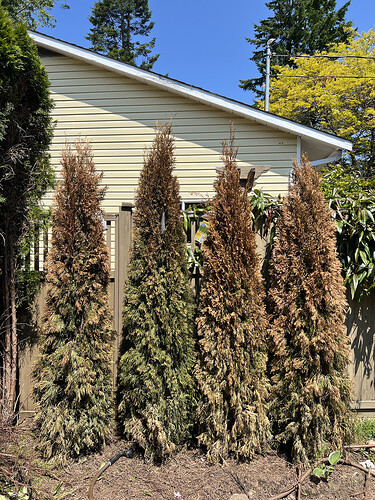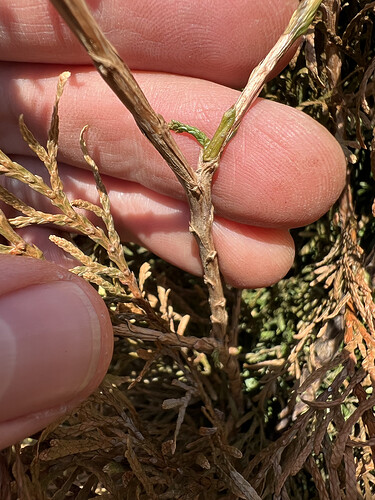Thank you to the Master Gardener volunteers from Gardening Advice Line, a partnership between Milner Gardens & Woodland and the Vancouver Island Master Gardeners Association for the following information:
————————————————
We are sorry to hear that you are having difficulties with your Thuga occidentalis, emerald cedar trees.
Brown patches such as we see in your photographs could be attributed to a few possible causes including drought stress, fungal infections, pruning or chemical issues.
It is possible these trees failed to establish in the first place as it looks to us in the photos most of each tree is affected.
They do require consistent moisture during dry periods. It is important to note that winds as we have experienced recently can be very drying
Is your soil well-drained and healthy? These are important considerations. You mention that the plants are not sitting in water so we can probably rule out drought or over-watering. To test you might want to dig around the root ball with your fingers and see is the soil is moist and if it feels like the plants are rooting.
Root rot can occur from poor-draining soil.
Also, ensure the root flare is exposed. (not dug in too deeply)
Were the trees in good shape when planted or were they root bound? Roots that are taking up most of the pot will create a barrier to water getting through and once the rootball has dried out, the more difficult it is to re-wet. In preparation for planting out, all new plants should be soaked in a container of water as long as it takes to completely wet the root ball. An inexpensive moisture meter is a good way to check how wet the interior of the root ball is.
A good method for dealing with root bound plants before transplanting is to first wash off all the planting medium, then cut off any roots that cannot be spread out like the spokes of a wheel. Plant with the root flare just slightly above soil level, water in well and mulch. Here is a link to a video presentation by one of our Master Gardeners on Root Prep for Successful Transplantingthat will walk you through the process.
Fungal infections can cause rust tip and tip blight - this starts at the tip, is this where yours started? Have you seen any sign of an insect infestation?
Excessive fertilizer, road salt runoff and herbicides can also cause browning. Because planting is a stressor, it is best not to further stress new plants by fertilizing for at least several months and up to a year.
There is a natural needle drop but again- yours appears overall as opposed to a shedding of some leaves.
Once completely brown you likely will not see new growth. You mentioned small patches of green, but your trees look pretty stressed.
If you feel that you have done all you responsibly could have, we suggest you try returning them to Costco. Nursery stock is sometimes grown in situations where growth is accelerated and plants heavily fertilized. They will not sustain their appearance, once in a customer’s garden.
We hope this has been of some help.
Kindly,
Dona and Gail

